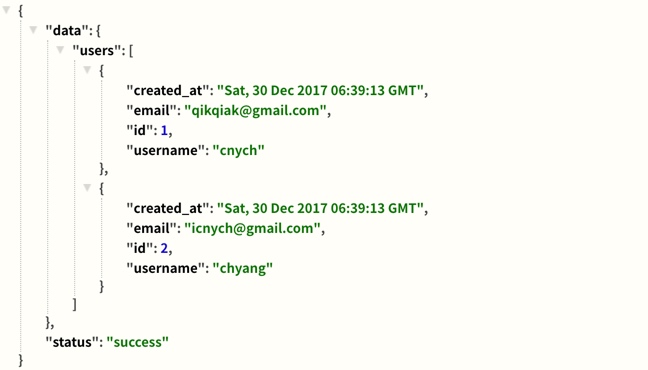Flask Blueprint
上节课完成了我们的基本测试,这节课我们来用Blueprint(蓝图)来对项目进行重构。
还不了解
Blueprint?可以先查看flask blueprint 文档。简单来说,Flask Blueprint提供了模块化管理程序路由的功能,使程序结构清晰、简单易懂。还是不太明白?没关系,这节课完成后我相信你一定会明白的~
在project目录下面新增api的目录,然后同样的需要在该目录下面新建几个文件:
(tdd3)$ touch __init__.py models.py views.py
然后更新views.py文件:
# project/api/views.py from flask import Blueprint, jsonify users_blueprint = Blueprint('users', __name__) @users_blueprint.route('/ping', methods=['GET']) def ping_pong(): return jsonify({ 'status': 'success', 'message': 'pong!' })
我们创建了一个users_blueprint的Blueprint实例,然后将该实例绑定到了ping_pong()方法上,这有什么用?继续往下看......
然后更新models.py文件:
# project/api/models.py import datetime from project import db class User(db.Model): __tablename__ = "users" id = db.Column(db.Integer, primary_key=True, autoincrement=True) username = db.Column(db.String(128), nullable=False) email = db.Column(db.String(128), nullable=False) active = db.Column(db.Boolean(), default=False, nullable=False) created_at = db.Column(db.DateTime, nullable=False) def __init__(self, username, email): self.username = username self.email = email self.created_at = datetime.datetime.utcnow()
我们可以看到上面的内容和project/__init__.py文件中的User类是一模一样的,没错,我们只是将这个地方代码分拆了而已,下面继续更新project/__init__.py文件:
# project/__init__.py import os from flask import Flask, jsonify from flask_sqlalchemy import SQLAlchemy # 初始化数据库 db = SQLAlchemy() def create_app(): # 初始化应用 app = Flask(__name__) # 环境配置 app_settings = os.getenv('APP_SETTINGS') app.config.from_object(app_settings) # 安装扩展 db.init_app(app) # 注册blueprint from project.api.views import users_blueprint app.register_blueprint(users_blueprint) return app
注意这里我们将实例化app的工作提取到了create_app的方法里面去,这是因为users_blueprint里面需要引用到当前文件下面的db实例,如果不把app放置到方法中去的话就会造成循环引用,什么意思?简单来说就是你中有我,我中有你,这对于程序来说是无法做出判断的~
接下来我们需要把所有其他文件引用project下面的app 的实例的都要替换掉(包括测试文件):
from project import create_app app = create_app()
更改完成以后我们重新构建镜像、创建数据库,最重要的是什么?测试:
(tdd3)$ docker-compose up -d users-db is up-to-date Starting users-service ... Starting users-service ... done (tdd3)$ docker-compose run users-service python manage.py recreate_db Starting users-db ... done (tdd3)$ docker-compose run users-service python manage.py test Starting users-db ... done test_app_is_development (test_config.TestDevelopmentConfig) ... ok test_app_is_production (test_config.TestProductionConfig) ... ok test_app_is_testing (test_config.TestTestingConfig) ... ok test_users (test_users.TestUserService) 确保ping的服务正常. ... ok ---------------------------------------------------------------------- Ran 4 tests in 0.086s OK
一切正常~~~
接下来我们根据RESTful的最佳实践利用TDD增加3个路由:
| Endpoint | HTTP Method | CRUD Method | Result |
|---|---|---|---|
| /users | GET | 查询 | 获取所有用户 |
| /users/:id | GET | 查询 | 获取单个用户 |
| /users | POST | 新增 | 新增用户 |
首先,在project/tests/test_users.py文件的TestUserService类中新增一个测试新增用户的方法:
def test_add_user(self): """确保能够正确添加一个用户的用户到数据库中""" with self.client: response = self.client.post( '/users', data=json.dumps(dict(username='cnych', email='qikqiak@gmail.com')), content_type='application/json', ) data = json.loads(response.data.decode()) self.assertEqual(response.status_code, 201) self.assertIn('qikqiak@gmail.com was added', data['message']) self.assertEqual('success', data['status'])
我们现在来执行测试肯定是不会通过的,因为路由/users还没实现的,所以接着我们在project/api/views.py中新增一个/users的处理方法:
# 注意要导入request from flask import Blueprint, jsonify, request, render_template from project import db from project.api.models import User @users_blueprint.route('/users', methods=['POST']) def add_user(): # 获取POST的数据 post_data = request.get_json() email = post_data.get('email') user = User(username=post_data.get('username'), email=email) db.session.add(user) db.session.commit() response_data = { 'status': 'success', 'message': '%s was added!' % email } return jsonify(response_data), 201
注意上面我们
add_user方法最终返回的数据,是从我们上面设计的测试代码中来的,这就是所谓的测试驱动我们的开发~
然后执行测试:
(tdd3)$ docker-compose run users-service python manage.py test Starting users-db ... done test_app_is_development (test_config.TestDevelopmentConfig) ... ok test_app_is_production (test_config.TestProductionConfig) ... ok test_app_is_testing (test_config.TestTestingConfig) ... ok test_add_user (test_users.TestUserService) 确保能够正确添加一个用户的用户到数据库中 ... ok test_users (test_users.TestUserService) 确保ping的服务正常. ... ok ---------------------------------------------------------------------- Ran 5 tests in 0.157s OK
测试通过~~~
但是还没完呢?现在我们的代码还不够健壮,如果程序中出现了错误或者异常该怎么办呢?比如:
- POST 的数据为空
- POST 的数据无效 - 比如JSON 对象是空的或者包含一个错误的key
- 如果添加的用户在数据中已经存在?
来对这些用例添加一些测试代码:
def test_add_user_invalid_json(self): """如果JSON对象为空,确保抛出一个错误。""" with self.client: response = self.client.post( '/users', data=json.dumps(dict()), content_type='application/json' ) data = json.loads(response.data.decode()) self.assertEqual(response.status_code, 400) self.assertIn('Invalid payload', data['message']) self.assertEqual('fail', data['status']) def test_add_user_invalid_json_keys(self): """如果JSON对象中没有username或email,确保抛出一个错误。""" with self.client: response = self.client.post( '/users', data=json.dumps(dict(email='qikqiak@gmail.com')), content_type='application/json' ) data = json.loads(response.data.decode()) self.assertEqual(response.status_code, 400) self.assertIn('Invalid payload', data['message']) self.assertEqual('fail', data['status']) with self.client: response = self.client.post( '/users', data=json.dumps(dict(username='cnych')), content_type='application/json' ) data = json.loads(response.data.decode()) self.assertEqual(response.status_code, 400) self.assertIn('Invalid payload', data['message']) self.assertEqual('fail', data['status']) def test_add_user_duplicate_user(self): """如果邮件已经存在确保抛出一个错误。""" with self.client: self.client.post( '/users', data=json.dumps(dict( username='cnych', email='qikqiak@gmail.com' )), content_type='application/json' ) response = self.client.post( '/users', data=json.dumps(dict( username='cnych', email='qikqiak@gmail.com' )), content_type='application/json' ) data = json.loads(response.data.decode()) self.assertEqual(response.status_code, 400) self.assertIn('Sorry. That email already exists.', data['message']) self.assertEqual('fail', data['status'])
现在我们支持测试命令,肯定是不会通过的,因为还没更新handler 呢:
from flask import Blueprint, jsonify, request, render_template from sqlalchemy import exc from project import db from project.api.models import User @users_blueprint.route('/users', methods=['POST']) def add_user(): # 获取POST的数据 post_data = request.get_json() if not post_data: response_data = { 'status': 'fail', 'message': 'Invalid payload.' } return jsonify(response_data), 400 email = post_data.get('email') username = post_data.get('username') try: user = User.query.filter_by(email=email).first() if not user: # 证明数据库中不存在该email的用户,可以添加 db.session.add(User(username=username, email=email)) db.session.commit() response_data = { 'status': 'success', 'message': '%s was added!' % email } return jsonify(response_data), 201 # 证明该email已经存在 response_data = { 'status': 'fail', 'message': 'Sorry. That email already exists.' } return jsonify(response_data), 400 except exc.IntegrityError as e: db.session.rollback() # 出现异常了,回滚 response_data = { 'status': 'fail', 'message': 'Invalid payload.' } return jsonify(response_data), 400
然后执行我们的测试命令,现在就能够测试通过了,如果出现了问题那么你应该仔细看看你的代码了~
接下来处理另外两个请求。
获取单个用户信息,还是先进行测试:
from project.api.models import User from project import db def test_get_user(self): user = User(username='cnych', email='qikqiak@gmail.com') db.session.add(user) db.session.commit() with self.client: response = self.client.get('/users/%d' % user.id) data = json.loads(response.data.decode()) self.assertEqual(response.status_code, 200) self.assertTrue('created_at' in data['data']) self.assertEqual('cnych', data['data']['username']) self.assertEqual('qikqiak@gmail.com', data['data']['email']) self.assertEqual('success', data['status'])
然后来编写获取单个用户请求的处理函数,更新project/api/views.py文件:
@users_blueprint.route('/users/<user_id>', methods=['GET']) def get_user(user_id): """获取某用户的详细信息""" user = User.query.filter_by(id=user_id).first() response_object = { 'status': 'success', 'data': { 'username': user.username, 'email': user.email, 'created_at': user.created_at } } return jsonify(response_object), 200
现在执行测试命令,测试能够通过了,那应该有哪一些错误处理的场景呢:
- 没有提供id
- id不存在
然后我们来针对上面两种场景添加测试代码:
def test_get_user_no_id(self): """如果没有id的时候抛出异常。""" with self.client: response = self.client.get('/users/xxx') data = json.loads(response.data.decode()) self.assertEqual(response.status_code, 400) self.assertIn('Param id error', data['message']) self.assertEqual('fail', data['status']) def test_get_user_incorrect_id(self): """如果ID不存在则要抛出异常""" with self.client: response = self.client.get('/users/-1') data = json.loads(response.data.decode()) self.assertEqual(response.status_code, 404) self.assertIn('User does not exist', data['message']) self.assertEqual('fail', data['status'])
然后根据上面我们的测试代码来更新get_user函数:
@users_blueprint.route('/users/<user_id>', methods=['GET']) def get_user(user_id): """获取某用户的详细信息""" response_object = { 'status': 'fail', 'message': 'User does not exist' } code = 404 try: user = User.query.filter_by(id=int(user_id)).first() if user: response_object = { 'status': 'success', 'data': { 'username': user.username, 'email': user.email, 'created_at': user.created_at } } code = 200 except ValueError: response_object = { 'status': 'fail', 'message': 'Param id error' } code = 400 finally: return jsonify(response_object), code
然后继续执行我们的测试命令,通过~~~
然后是获取所有的用户列表的请求,这节就让我们的读者朋友自己来动手实践吧,最终代码我们会同步到github上去的,记住要用TDD的思想,先写测试代码,然后编写我们的网络请求函数,然后编写一些异常场景下面的测试代码,继续增强我们的请求函数,再测试。
上面的步骤完成后,我们试着在浏览器中打开http://127.0.0.1:5001/users接口,不出意外的话我们会看到如下的json信息输出:
{ "data": { "users": [] }, "status": "success" }
这是因为我们的数据库中还没有任何的数据,所以肯定这里得到的是一个空的数据列表。为了测试方便,我们在manage.py文件中增加一个命令来添加一些测试数据吧:
from project.api.models import User @manager.command def seed_db(): """Seeds the database.""" db.session.add(User(username='cnych', email="qikqiak@gmail.com")) db.session.add(User(username='chyang', email="icnych@gmail.com")) db.session.commit()
然后我们在命令行中执行seed_db命令:
(tdd3)$ docker-compose run users-service python manage.py seed_db
执行成功后,我们再次在浏览器中打开上面的接口,已经能够看到用户列表信息了。
